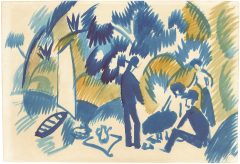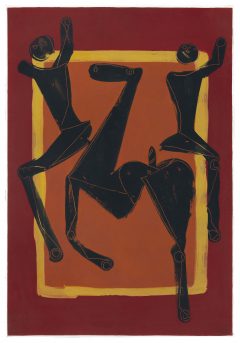Ernst Ludwig Kirchner
Sitzende Frau mit einem Hut in einem Restaurant
ca. 1912

Watercolour, opaque colour and pencil on paper
34.2 × 27 cm / 13 7/16 × 10 5/8 in
Signed also marked “KA 18” and inscribed “Leihgeber: F. Gygi Florastrasse 6” on the verso
This work is documented in the Ernst Ludwig Kirchner Archive Wichtrach/Bern
Collection Gervais, Zürich/Lyon [= The artist’s estate]; Collection F. Gygi, Bern (since 1948, purchased at Arnold Rüedlinger at the Kunsthalle in Bern in context of the exhibition “Paula Modersohn und die Maler der Brücke”); Estate F. Gygi, Bern
- Galerie Ludorff, "Meisterwerke", Düsseldorf 2020
- Galerie Ludorff, "40 Jahre 40 Meisterwerke", Dusseldorf 2015
- Galerie Ludorff, "Meisterwerke", Düsseldorf 2020
- Galerie Ludorff, "Meisterwerke", Düsseldorf 2020, S. 52
Kirchner's drawings are perhaps the purest and most beautiful of his work. They are unconscious and unintentional, a mirror of the feelings of a person of our time. A)
The watercolour pencil drawing 'Sitzende Frau mit einem Hut in einem Restaurant' was created around 1912, when Ernst Ludwig Kirchner had already been living in Berlin for a year, the atmosphere of which had a clear influence on the artist's visual language and aesthetic. The contour lines in his drawings are shorter and repeated, the sometimes heavy hatching testifies to the pace and rhythm of the big city.B) In Sitting Woman with a Hat in a Restaurant, the fine contour lines and short, concise strokes of the pencil are still clearly visible thanks to the watercolour and opaque paint applied afterwards. The flat, dark application of paint in quick, almost spidery brushstrokes makes the restaurant scene appear restless and compact, while the red-brown and black-green colours reinforce the effect. Kirchner contrasts the narrowness and hectic pace of the room with the calm female figure at the centre of the painting. Her blue and beige-coloured clothing, which contrasts with her lightly tanned skin, reinforces the contrast with the room, as do her soft expression and the fine pencil lines of her contour.
In a relaxed, upright posture, the woman has taken a seat in the corner of a large dark sofa. There is a bottle of wine and a glass on the table in front of her. With one arm resting on the back of the sofa and her hands resting on her thighs, she looks at her counterpart with a patient, friendly gaze. Her large hat, typical of the fashion of the time, is just as simple in colour and structure as the long jacket over her dress and the light-coloured shawl around her shoulders. The flat, dark background framing her is broken up here and there by small, bright accents: a light ochre-coloured chair back in the right middle ground, perhaps a window on the right, highlighted with light green, and two pictures on the wall, whose fleeting motifs can only be guessed at. It is precisely the fleeting in my drawing that is most important , writes Kirchner, because I capture the most subtle first sensation through it. C) All too detailed and deliberate observations would destroy precisely this sensation of first seeing that Kirchner depicts. Ernst Ludwig Kirchner had internalised spontaneous drawing at least since his time with the artists' association 'Brücke'. His ability to reproduce what he saw directly and the associated mood of a fleeting moment is particularly impressive in Sitting Woman with a Hat in a Restaurant.
Annkathrin Schwedhelm Art historian, North Rhine-Westphalia
A) Louis de Marsalle (Ernst Ludwig Kirchner), 'Drawings by E.L. Kirchner', 1920; in: Lothar Grisebach (ed.), 'Ernst Ludwig Kirchner. Davoser Tagebuch', Witrach/Bern 1997, pp. 220 - 225, p. 224.
B) Cf. Wolfgang Henze, 'Bedeutung und Funktion der Zeichnungen im Werk von Ernst Ludwig Kirchner. Ein Arbeitsbericht aus dem Archiv zum Gesamtwerk': in: Anita Boulek-Hammer (ed.), 'Ernst Ludwig Kirchner. ‘Ektase des ersten Sehens’ und gestaltete Form', Berlin 2004, pp. 22 - 37, p. 30.
C) Ernst Ludwig Kirchner, 'Diary entry from 7 Sept. 1925', in: Lothar Grisebach (ed.), 'Ernst Ludwig Kirchner. Davos Diary', Witrach/Bern 1997, p. 88.





